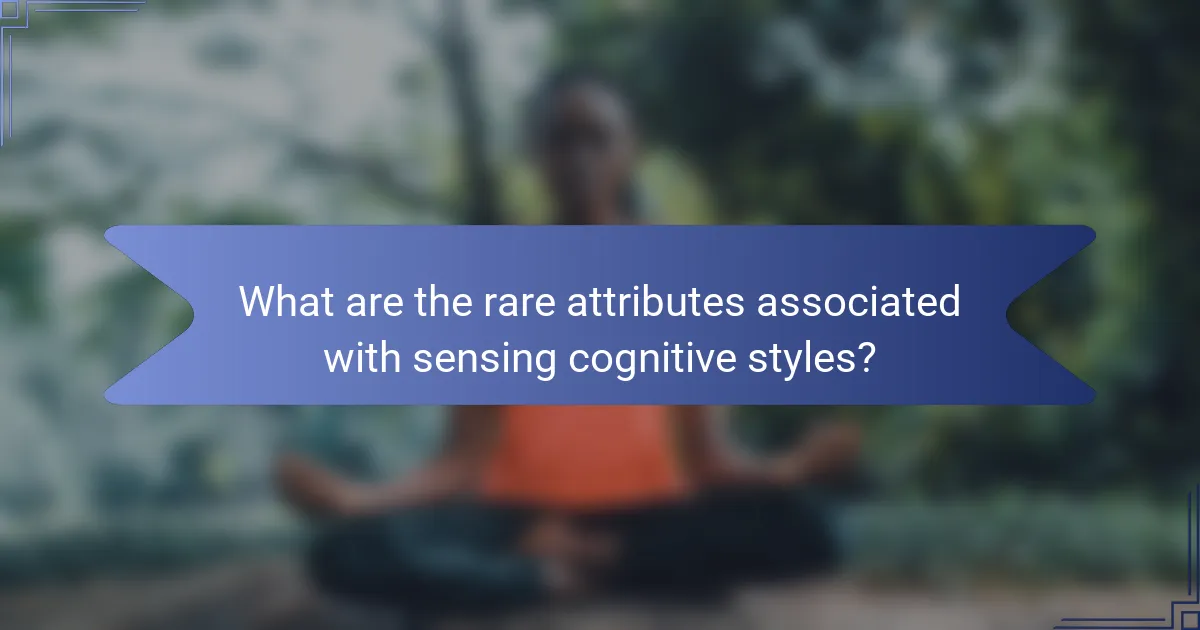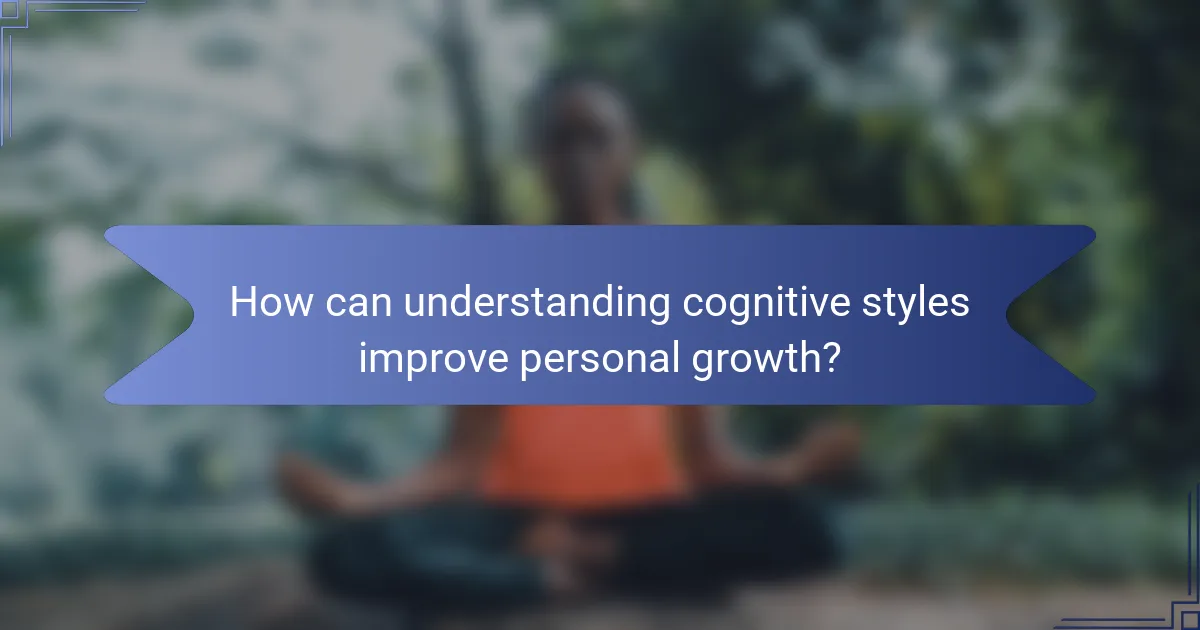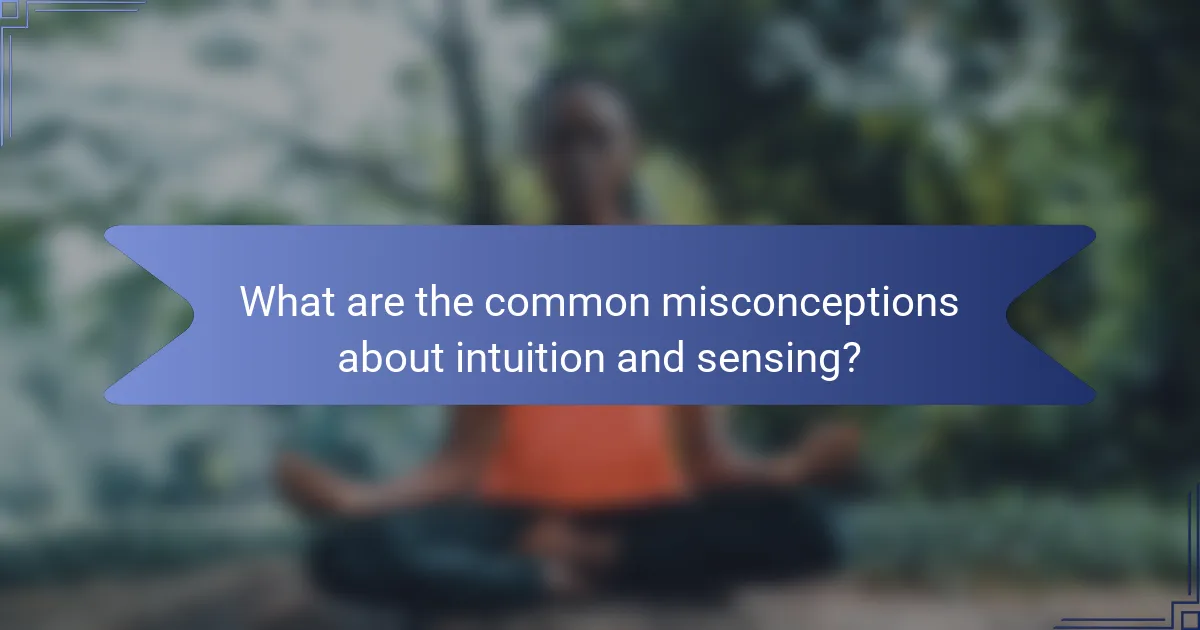Understanding cognitive styles, specifically intuition and sensing, is crucial for personal growth. Intuition emphasizes abstract thinking and innovation, while sensing focuses on concrete details and practical applications. Recognizing these differences can enhance self-awareness and adaptability. This article explores the attributes of each style, their impact on learning and problem-solving, and strategies for leveraging these strengths in personal development.

What are the key differences between intuition and sensing in cognitive styles?
Intuition and sensing represent distinct cognitive styles, influencing how individuals process information. Intuition focuses on patterns and possibilities, while sensing emphasizes concrete details and present realities.
Intuition often leads to abstract thinking and future-oriented insights, promoting creativity. Sensing, on the other hand, supports practical decision-making based on observable data.
These cognitive styles affect learning preferences and problem-solving approaches. For personal growth, recognizing one’s dominant style can enhance self-awareness and adaptability.
In summary, intuition and sensing differ in their focus on abstract versus concrete information, shaping how individuals engage with the world.
How do intuition and sensing manifest in everyday decision-making?
Intuition often leads to quick, gut-feeling decisions, while sensing relies on observable data. Intuitive decision-makers may prioritize feelings and insights, whereas sensing individuals focus on facts and details. This distinction affects personal growth, as recognizing one’s cognitive style can enhance decision-making strategies. For example, someone with a sensing preference might benefit from structured analysis, while an intuitive person could explore creative solutions. Understanding these styles fosters better choices and personal development.
What are the psychological theories explaining intuition and sensing?
Intuition and sensing are explained by various psychological theories, highlighting distinct cognitive styles. Intuition emphasizes pattern recognition and holistic thinking, while sensing focuses on concrete details and present realities. Theories like Carl Jung’s psychological types illustrate these differences, suggesting that intuitive individuals rely on internal insights, whereas sensing individuals prioritize sensory experiences. Understanding these cognitive styles can enhance personal growth by fostering self-awareness and improving decision-making processes.
How does Jung’s theory of personality relate to cognitive styles?
Jung’s theory of personality highlights the distinction between intuition and sensing, which directly relates to cognitive styles. Intuition emphasizes abstract thinking and future possibilities, while sensing focuses on concrete details and present realities. Understanding these styles aids personal growth by aligning decision-making approaches with individual preferences. For example, intuitive individuals may thrive in creative environments, whereas sensing types excel in practical tasks. This alignment fosters effective learning and development strategies tailored to cognitive preferences.
What role does the Myers-Briggs Type Indicator play in understanding these styles?
The Myers-Briggs Type Indicator (MBTI) enhances understanding of cognitive styles by categorizing individuals into distinct personality types. This framework helps individuals identify their preference for intuition or sensing, which influences their personal growth and development. Intuitive individuals often focus on patterns and possibilities, while sensing individuals prefer concrete facts and details. Recognizing these differences aids in tailoring personal development strategies, fostering better communication and collaboration among diverse cognitive styles.

What are the universal attributes of intuitive and sensing cognitive styles?
Intuitive and sensing cognitive styles share universal attributes that influence perception and decision-making. Both styles affect how individuals process information, approach problem-solving, and interact with their environment.
Intuitive individuals focus on patterns and possibilities, valuing abstract concepts and future-oriented thinking. They often prioritize innovation and creativity in their decision-making. In contrast, sensing individuals emphasize concrete details and present realities, relying on sensory input and practical experiences. They tend to be grounded and detail-oriented, favoring established methods and facts.
Understanding these attributes can enhance personal growth by allowing individuals to leverage their cognitive strengths. Intuitive thinkers can benefit from grounding their ideas in practical applications, while sensing individuals may explore broader possibilities to foster creativity.
How do intuitive individuals approach problem-solving?
Intuitive individuals approach problem-solving by relying on their instincts and insights. They often see the bigger picture and connect disparate ideas quickly. This cognitive style allows them to generate creative solutions without extensive analysis. Intuitive thinkers embrace ambiguity and are comfortable with uncertainty, which can lead to innovative outcomes. They prioritize holistic understanding over detailed data, often trusting their gut feelings to guide their decisions.
What characteristics define sensing individuals in their thought processes?
Sensing individuals are characterized by their focus on concrete details and practical experiences. They prefer facts over theories, often relying on their senses to guide their understanding. This cognitive style emphasizes present realities, making them detail-oriented and observant. Sensing types tend to appreciate structured environments and clear instructions, valuing hands-on learning and real-world applications.

What unique benefits do intuitive thinkers bring to personal development?
Intuitive thinkers enhance personal development through unique insights, creativity, and holistic problem-solving. They excel in recognizing patterns and envisioning possibilities, which fosters innovative approaches to growth. Their ability to connect disparate ideas leads to breakthroughs in self-awareness and emotional intelligence. As a result, intuitive thinkers often inspire others and create transformative experiences.
How can intuition enhance creativity and innovation?
Intuition enhances creativity and innovation by enabling quick, instinctive decision-making. It allows individuals to tap into subconscious knowledge and experiences, fostering unique ideas. This cognitive style contrasts with sensing, which relies on detailed analysis and observation. Intuitive thinkers often generate novel solutions by making connections that others may overlook. As a result, organizations that value intuition can cultivate a more dynamic and innovative environment.
What strategies can intuitive individuals use for effective goal setting?
Intuitive individuals can enhance goal setting by leveraging their strengths in creativity and vision. They should employ visualization techniques, break goals into smaller, manageable tasks, and regularly reflect on their progress to align with their intuitive insights. Emphasizing flexibility allows them to adapt goals as new insights emerge.

What are the rare attributes associated with sensing cognitive styles?
Rare attributes associated with sensing cognitive styles include heightened sensory awareness, preference for concrete information, and a focus on present experiences. These individuals often excel in detail-oriented tasks and practical problem-solving. Their approach contrasts with intuitive styles, which prioritize abstract concepts and future possibilities. Understanding these rare attributes can enhance personal growth by fostering effective communication and collaboration strategies.
How do sensing individuals excel in detail-oriented tasks?
Sensing individuals excel in detail-oriented tasks due to their strong observational skills and preference for concrete information. They focus on specifics and practical applications, allowing them to efficiently analyze and execute tasks requiring precision. This attention to detail is a root attribute of their cognitive style, enhancing their effectiveness in roles demanding meticulousness. Their ability to process sensory data enables them to identify patterns and nuances that others might overlook, leading to higher accuracy in task completion.
What challenges do sensing individuals face in abstract thinking?
Sensing individuals often struggle with abstract thinking due to their preference for concrete information and practical details. This cognitive style may limit their ability to conceptualize ideas beyond immediate experiences. They may face challenges in recognizing patterns, making connections between unrelated concepts, and engaging in hypothetical reasoning. As a result, personal growth may be hindered by difficulty in envisioning future possibilities or exploring theoretical frameworks.

How can understanding cognitive styles improve personal growth?
Understanding cognitive styles, such as intuition and sensing, enhances personal growth by tailoring learning and decision-making strategies. Intuitive individuals often excel in abstract thinking and innovation, while sensing types thrive on concrete details and practical applications. Recognizing these differences allows individuals to leverage their strengths, fostering self-awareness and targeted development. This understanding can lead to improved communication, collaboration, and conflict resolution, ultimately promoting a more fulfilling personal and professional life.
What techniques can be used to balance intuition and sensing in decision-making?
To balance intuition and sensing in decision-making, individuals can employ techniques such as reflective practice, data analysis, and scenario planning. Reflective practice encourages individuals to evaluate past decisions, integrating intuitive insights with sensory data. Data analysis involves gathering quantitative information to complement intuitive judgments, ensuring decisions are grounded in reality. Scenario planning allows for exploration of various outcomes, combining intuitive foresight with empirical evidence to enhance decision-making effectiveness.
How can individuals leverage their cognitive style for better relationships?
Individuals can leverage their cognitive style by recognizing and adapting to their intuition or sensing preferences. Intuitive individuals often excel in abstract thinking and future-oriented discussions, fostering creativity in relationships. Sensing individuals focus on concrete details and present experiences, enhancing practical communication. By understanding these styles, individuals can tailor their interactions to meet the needs of their partners, leading to more effective problem-solving and deeper connections. Awareness of cognitive styles promotes empathy and reduces misunderstandings, ultimately enhancing relationship satisfaction.

What are the common misconceptions about intuition and sensing?
Intuition is often seen as infallible, while sensing is viewed as less valuable. This misconception overlooks the unique strengths of each cognitive style. Intuition can lead to insights without concrete evidence, but it may also result in errors. Sensing relies on observable data, providing a solid foundation for decision-making. Understanding these differences fosters personal growth and enhances development strategies.
How do cultural perceptions influence the understanding of these styles?
Cultural perceptions significantly shape the understanding of intuition and sensing styles. Different cultures prioritize various cognitive approaches, impacting personal growth strategies. For instance, collectivist cultures may value sensing, emphasizing practical experiences and community input. In contrast, individualistic cultures often favor intuition, promoting innovative thinking and personal insights. These distinctions influence how individuals engage with their cognitive styles, affecting their development. Understanding these cultural nuances can enhance adaptability and effectiveness in personal growth initiatives.
What biases might arise from a preference for one cognitive style over the other?
A preference for intuition over sensing can lead to biases such as overgeneralization and neglect of details. Intuitive thinkers may overlook critical facts, leading to decisions based on assumptions rather than evidence. Conversely, a preference for sensing may result in an underappreciation of abstract concepts, limiting creative problem-solving. These biases can hinder personal growth by restricting the cognitive flexibility necessary for balanced decision-making.

What best practices can enhance personal development through cognitive styles?
To enhance personal development through cognitive styles, individuals should leverage their intuitive or sensing preferences. Intuitive thinkers often benefit from exploring abstract concepts and future possibilities, while sensing individuals thrive on concrete details and present realities. Emphasizing these strengths can lead to more effective learning and growth strategies.
Intuitive individuals should engage in creative problem-solving and brainstorming sessions to harness their visionary capabilities. This approach fosters innovation and adaptability. In contrast, sensing individuals can benefit from structured learning environments that emphasize hands-on experiences and practical applications, enhancing their comprehension and retention.
Integrating both cognitive styles in collaborative settings can create a balanced approach, allowing for diverse perspectives and comprehensive solutions. This synergy promotes holistic personal development, as team members can learn from one another’s strengths and methodologies.
How can individuals identify their cognitive style effectively?
Individuals can identify their cognitive style by reflecting on their decision-making processes and preferences. Start by assessing whether you rely more on intuition or sensing in daily situations. Intuitive thinkers often focus on possibilities and future outcomes, while sensing individuals prioritize concrete facts and present realities.
To effectively evaluate your style, consider keeping a journal to track your thoughts and decisions. Reflect on instances where you felt most comfortable or challenged. Additionally, personality assessments can provide insights into your cognitive preferences. Engaging in discussions with diverse groups can also reveal how you process information differently from others.
By understanding these attributes, you can leverage your cognitive style for personal growth, enhancing your decision-making and problem-solving skills.
What actionable steps can be taken to develop both intuition and sensing skills?
To develop both intuition and sensing skills, practice mindfulness and engage in reflective exercises. Start by journaling daily to enhance self-awareness and recognize patterns in your thoughts. Participate in activities that require observation, such as nature walks, to strengthen your sensing abilities. Engage in discussions that challenge your perspective, fostering intuitive thinking. Finally, balance analytical tasks with creative endeavors to stimulate both cognitive styles.
What common mistakes should be avoided when applying cognitive styles to personal growth?
To effectively apply cognitive styles for personal growth, avoid common mistakes like oversimplifying intuition and sensing, neglecting individual differences, and failing to adapt strategies. Recognizing the unique attributes of each style enhances personal development. Focus on integrating both styles rather than favoring one, as this balance fosters comprehensive growth. Ignoring the context of situations can lead to ineffective applications, so always tailor approaches to specific scenarios.